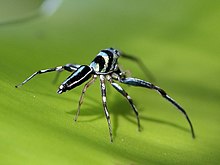
Austracantha is a genus of spider with a single species, Austracantha minax, commonly known as the jewel spider or the Christmas spider. It is a member of the family Araneidae and is endemic to Australia. They are relatively small spiders, reaching a maximum total body length of only around 12 mm (0.47 in) for females, and 5 mm (0.20 in) for males. Their abdomen has six distinctive projections ("spines") that makes them easy to identify. They are predominantly a shiny black, with variable white, yellow, and orange patterns. Melanistic forms also occur during autumn. They are facultatively gregarious, and can be found in large aggregations of overlapping orb webs. They feed on small flying insects that get entangled in their webs. They are harmless to humans, though the webs can be a nuisance for bushwalkers. They are most abundant during the summer months.
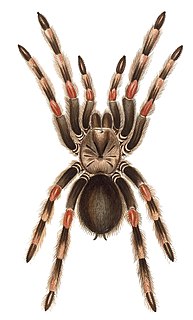
Brachypelma smithi is a species of spider in the family Theraphosidae (tarantulas) native to Mexico. It has been confused with Brachypelma hamorii; both have been called Mexican redknee tarantulas. Mexican redknee tarantulas are a popular choice as pets among tarantula keepers. Many earlier sources referring to B. smithi either relate to B. hamorii or do not distinguish between the two species. B. smithi is a terrestrial tarantula native to Pacific coast of the Mexican state of Guerrero.
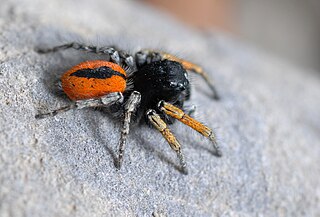
Philaeus chrysops is a species of jumping spider (Salticidae).

The black house spider or common black spider is a common species of cribellate Australian spider, introduced to New Zealand and Japan. A closely related species, Badumna longinqua, the grey house spider, has a similar distribution, but has also been introduced to the Americas.
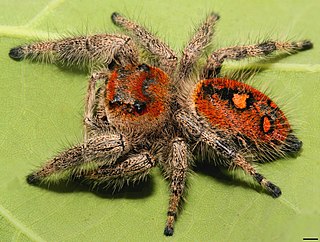
Phidippus regius, known commonly as the regal jumper, is a species of jumping spider in eastern North America.
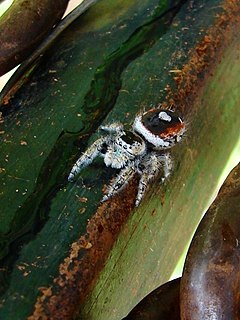
Phidippus californicus is a species of jumping spider. It is found in the southwestern United States and northern Mexico.

Prostheclina pallida is a species of spider in the family Salticidae, native to Eastern Australia. It was described by Keyserling in 1882, and remained the only species in the genus until 2007, when six more species were described.

Cosmophasis umbratica is a species of jumping spider found in South and Southeast Asia. These spiders are known for their brilliant, shiny ultraviolet light. They are members of the family Salticidae and the genus Cosmophasis. They are commonly spotted on green vegetation. C. umbratica shows extreme dimorphism when viewed under UV light: males reflect UV on all body parts that are displayed during intraspecific interaction, while females and juveniles do not reflect UV at all. It seems that C. umbratica uses this in sexual signaling. A similar phenomenon is found in some butterflies. For example, several species of Colias and Gonepteryx, both of the family Pieridae, also display sexual signaling.
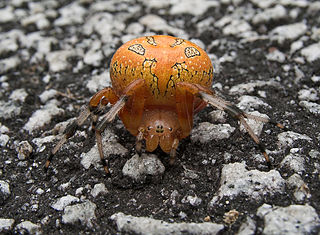
Araneus marmoreus, commonly called the marbled orbweaver, is a species of spider belonging to the family Araneidae. It is sometimes also called the pumpkin spider from the resemblance of the female's inflated abdomen to an orange pumpkin. It has a Holarctic distribution. Like other orbweavers, the marbled orbweaver is not considered a medically significant species.

Maevia inclemens is a relatively common and colorful jumping spider of North America. In the males there are two forms, a very rare phenomenon in zoology. These use different courting displays, and differ in appearance: the "tufted" morph has a black body and pedipalps ("palps"), three black tufts across its "head", and pale legs; and the "gray" morph has black and white stripes all over its body and legs, orange palps, and no tufts. However, each form accounts for 50% of the adult males, and they are equally successful in mating. A female of Maevia inclemens is 6.5 to 8.0 millimetres long, while males are 4.75 to 6.50 millimetres long.

Metepeira labyrinthea, the labyrinth orbweaver, is a spider, with thin legs and a round, bulbous abdomen It is a member of the genus Metepeira in the family Araneidae. The female’s length is 5.3 mm, its carapace 2.3 mm, abdomen 3.3 mm, and extended legs 18.4 mm. The carapace is brown or gray, and the abdomen is dark with a white pattern. The legs alternate pale brown and dark brown, and the sternum is dark brown with a longitudinal yellow mark. The male spider is three-quarters of the female’s length, or slightly larger, with a darker carapace and with greater contrast between dark and light areas of the legs. Metepeira are easily distinguished from other Araneidae by their light eye region, white median line on the sternum, relative length of the leg segments, small male palpus, weakly sclerotized epigyne and the special composite web.

Menemerus bivittatus is a spider in the family Salticidae commonly known as the gray wall jumper. It is a pantropical species and is usually found on the walls of buildings or on tree trunks where it stalks its prey.

Pachistopelma rufonigrum is a species of theraphosid, contained within the Aviculariinae subfamily. It is endemic to Brazil.

Euryattus bleekeri, known as Bleeker's jumping spider, is a species of spider in the family Salticidae. It is found from Sri Lanka to Queensland.
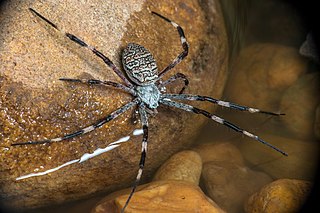
Argiope dietrichae is a rare species of orb-web spider found in the northern parts of Western Australia and the Northern Territory. It was first described by Levi in 1983, and it was named for Amalie Dietrich who collected specimens for the Godeffroy Museum in Hamburg.

Zenodorus orbiculatus, the round ant eater, is a species of ant-hunting jumping spider found in Australia. The species was first formally named by Eugen von Keyserling in 1881 as Hasarius orbiculatus.
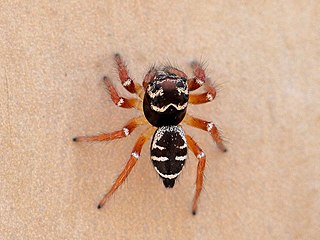
Zenodorus metallescens is a species of ant-hunting jumping spider found in Papua New Guinea and Australia. The common name is cast-iron jumping spider as the white patterns on the abdomen resemble cast-iron designs in fences and gates.

Cosmophasis bitaeniata is a species of jumping spider found in Indonesia, Papua New Guinea, Australia, Micronesia, and Fiji. The common name is green ant hunter as it preys on the larvae of green tree ants.
Ocrepeira klamt is a species of orb-weaving spider found in the Colombian paramos, named in honour of the German teacher Ulrike Klamt. Due to an armed conflict, the region in which Ocrepeira klamt can be found has been largely inaccessible until recently. Both phenotypic and genotypic studies were used to substantiate the finding that Ocrepeira klamt is a new species of the neotropical orb-weaving spiders. In addition to Ocrepeira klamt, various other neotropical orb-weaving in the genera Ocrepeira spiders have been found in the paramos region. Ocrepeira Marx, Ocrepeira globoas, and Ocrepeira subrufa are various examples of orb-weaving spiders found along with Ocrepeira klamt. Ocrepeira klamt and other orb-weaving spiders can be easily differentiated from the other genera from the shape of the carapace and the anterior humps on the abdomen. In addition, notable morphological characteristics of Ocrepeira include a patterned abdomen, a black abdomen with white spots. Presence of the carapace wide in the eye region, structure of the posterior median eyes, and abdomen physiology, including two anterior humps, confirmed the placement of Ocrepeira klamt into the Ocrepeira genus. Furthermore, unique genitalia structure and the altitude it lives separates it from other species in the genus. As compared to other species in the genus, Ocrepeira klamt was found at the highest elevation of all the Ocrepeira species in the region at 3,650 metres (11,980 ft).

Cosmophasis lami, also known as the Lami Beach northern jumping spider, is a species of jumping spider in the genus Cosmophasis. It is first described by Berry, Beatty & Prószynski in 1997.




